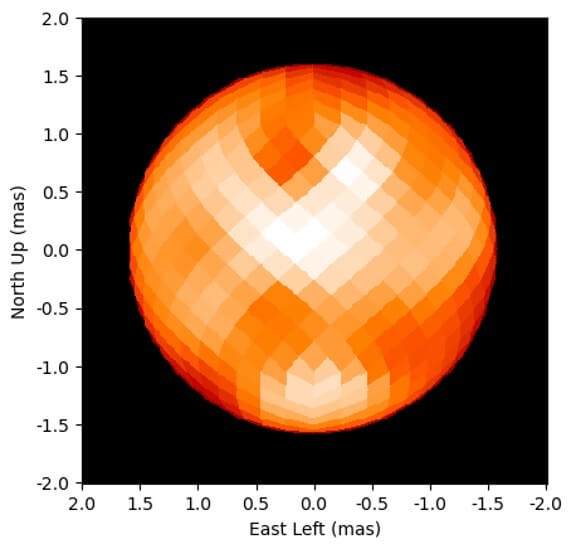
- Polaris, the North Star, was the subject of observations by the CHARA Array in California.
- Polaris is a variable star, and these observations were the first glimpse of what a Cepheid variable star’s surface looks like.
- The most surprising finding was that Polaris has large bright and dark spots on its surface.
Georgia State University published this original story on August 20, 2024. Edits by EarthSky.
Polaris, the North Star, has spots on its surface
Researchers using Georgia State University’s Center for High Angular Resolution Astronomy (CHARA) Array have identified new details about the size and appearance of the North Star, also known as Polaris. The most remarkable finding was the large bright and dark spots on the star’s surface. The Astrophysical Journal published the new peer-reviewed research on August 20, 2024.
The North Star is a variable star
Earth’s North Pole points to a direction in space marked by the North Star. Polaris is both a navigation aid and a remarkable star in its own right. It is the brightest member of a triple-star system and is a pulsating variable star. Polaris gets brighter and fainter periodically as the star’s diameter grows and shrinks over a four-day cycle.
Polaris is a kind of star known as a Cepheid variable. Astronomers use these stars as “standard candles,” because their true brightness depends on their period of pulsation. Brighter stars pulsate slower than fainter stars. How bright a star appears in the sky depends on the star’s true brightness and the distance to the star. Because we know the true brightness of a Cepheid based on its pulsational period, astronomers can use them to measure the distances to their host galaxies and to infer the expansion rate of the universe.
Studying Polaris
A team of astronomers led by Nancy Evans at the Center for Astrophysics | Harvard & Smithsonian observed Polaris using the CHARA optical interferometric array of six telescopes at Mount Wilson, California. The goal of the investigation was to map the orbit of the close, faint companion that orbits Polaris every 30 years. Evans said:
The small separation and large contrast in brightness between the two stars makes it extremely challenging to resolve the binary system during their closest approach.
The CHARA Array combines the light of six telescopes that are spread across the mountaintop at the historic Mount Wilson Observatory. By combining the light, the CHARA Array acted like a 330-meter telescope to detect the faint companion as it passed close to Polaris. The observations of Polaris were recorded using the MIRC-X camera, which was built by astronomers at the University of Michigan and Exeter University in the U.K. The MIRC-X camera has the remarkable ability to capture details of stellar surfaces.
The team successfully tracked the orbit of the close companion and measured changes in the size of the Cepheid as it pulsated. The orbital motion showed that Polaris has a mass five times larger than that of the sun. The images of Polaris showed that it has a diameter 46 times the size of the sun.
Surprising view of its surface
The biggest surprise was the appearance of Polaris in closeup images. The CHARA observations provided the first glimpse of what the surface of a Cepheid variable looks like.
Gail Schaefer, director of the CHARA Array, said:
The CHARA images revealed large bright and dark spots on the surface of Polaris that changed over time.
The presence of spots and the rotation of the star might be linked to a 120-day variation in measured velocity. John Monnier, an astronomy professor at the University of Michigan, said:
We plan to continue imaging Polaris in the future. We hope to better understand the mechanism that generates the spots on the surface of Polaris.
The CHARA Array
The new observations of Polaris were made and recorded as part of the open access program at the CHARA Array, where astronomers from around the world can apply for time through the National Optical-Infrared Astronomy Research Laboratory (NOIRLab).

The CHARA Array open access program is funded by the National Science Foundation (grant AST-2034336). Institutional support for the CHARA Array is provided by Georgia State’s College of Arts & Sciences and the Office of the Vice President for Research and Economic Development.
Bottom line: Observations of Polaris, the North Star, show it has large bright and dark spots on its surface. It’s the first glimpse of what the surface of a Cepheid variable looks like.
Source: The Orbit and Dynamical Mass of Polaris: Observations with the CHARA Array











